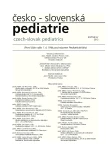Terminálne zlyhanie obličiek u detí na Slovensku
Epidemiológia z Európskej perspektívy
Authors:
G. Koľvek 1; Z. Kizeková 2; M. Dluholucký 3; M. Antonyová 4; Ľ. Podracká 1
Authors‘ workplace:
1. Klinika detí a dorastu lekárskej fakulty Univerzity P. J. Šafárika a Detskej fakultnej nemocnice, Košice
prednosta prof. MUDr. Ľ. Podracká, CSc.
1; 1. Detská klinika Univerzity Komenského a Detskej fakultnej nemocnice s poliklinikou, Bratislava
prednosta doc. MUDr. O. Červeňová, PhD.
2; 2. Detská klinika SZU a Detskej fakultnej nemocnice s poliklinikou, Banská Bystrica
prednosta prof. MUDr. K. Kralinský, PhD.
3; Klinika detí a dorastu Jeséniovej lekárskej fakulty a Univerzitnej nemocnice, Martin
prednosta prof. MUDr. P. Bánovčin, CSc.
4
Published in:
Čes-slov Pediat 2012; 67 (Suppl 1): 18-24.
Category:
Original Papers
Overview
Introduction:
The population of children with end-stage renal disease (ESRD) is growing, but reliable epidemiological information on its occurrence is not easy to obtain. The aim of this study was to determine the epidemiology of renal replacement therapy (RRT) in children with ESRD in Slovakia; compare it with previously published data on Slovakia as well as data on neighbouring countries and to explore the aetiology of ESRD.
Methods:
The data on the occurrence of RRT were collected over the years 2003–2009. The incidence and prevalence was calculated per million age related population (pmarp) and per million total population (pmtp) respectively. The data were compared with two earlier Slovak studies and with European data from the European Society of Paediatric Nephrology.
Results:
The median annual incidence of RRT in children younger than 15 years was 6.6 pmarp (1.5 pmtp). The prevalence rate on 31st December 2009 was 24.1 pmarp. Differences between 2002 and 2009 (18.6 pmarp, 3.2 pmtp) were not statistically significant. The comparison with neighboring countries and with the European average shows no significant difference in incidence, while prevalence is significantly lower compared to neighboring Austria and some other (mostly western) European countries. The aetiology of ESRD mainly concerned congenital anomalies (34.6%) and cystic kidney diseases (19.2%).
Conclusion:
The trend in the incidence and the prevalence of RRT in Slovak children is slightly positive, but the differences between the last published study (2002) and present are not statistically significant. Compared with the European average, the prevalence of RRT was significantly lower.
Key words:
end-stage renal disease, incidence, prevalence, etiology
Sources
1. Mehls O, Rigden S, Ehrich JH, Berthoux F, Jones EH, Valderrabano F. Report on management of renal failure in Europe, XXV, 1994. The child-adult interface. The EDTA-ERA Registry. European Dialysis and Transplant Association-European Renal Association. Nephrol Dial Transplant 1996; 11 (Suppl 1): 22–36.
2. van der Heijden BJ, van Dijk PC, Verrier-Jones K, Jager KJ, Briggs JD. Renal replacement therapy in children: data from 12 registries in Europe. Pediatr Nephrol 2004; 19 (2): 213–221.
3. van Stralen KJ, Tizard EJ, Verrina E, Schaefer F, Jager KJ, European Society for Paediatric Nephrology/European Renal Association-European Dialysis and Transplant Association (ESPN/ /ERA-EDTA) registry study group. Demographics of paediatric renal replacement therapy in Europe: 2007 annual report of the ESPN/ERA-EDTA registry. Pediatr Nephrol 2010; 25 (7): 1379–1382.
4. Reiss U, Wingen AM, Scharer K. Mortality trends in pediatric patients with chronic renal failure. Pediatr Nephrol 1996; 10 (1): 41–45.
5. Warady BA, Chadha V. Chronic kidney disease in children: the global perspective. Pediatr Nephrol 2007; 22 (12): 1999–2009.
6. Zvara V, Šašinka M, Pribylincová V, Kaiserová E, Bcrošová E, Řezníček J. Epidemiólgia chronickej renálnej insuficiencie u detí v SSR. Čs Pediat 1978; 33 (6): 321–325.
7. Podracká Ľ, Kovács L. Epidemiológia chronickej renálnej insuficiencie u detí na Slovensku. Čes-slov Pediat 2004; 7: 331.
8. Podracká Ľ, Koľvek G, Kizeková Z, Dluholucký M, Antonyová M. História registra detí s chronickou renálnou insuficienciou v Európe a na Slovensku. Lek Obz 2010; 59 (6): 231–234.
9. Briggs JD. The ERA-EDTA Registry returns to Amsterdam. Nephrol Dial Transplant 2000; 15 (9): 1326–1327.
10. ERA-EDTA Registry. ERA-EDTA Registry 2008 annual report. Amsterdam: Academic Medical Centre, Department of Medical Informatics, 2010.
11. ESPN/ERA-EDTA Registry. ESPN/ /ERA-EDTA Registry 2007, Annual Report 2009.
12. ESPN/ERA-EDTA Registry. ESPN/ /ERA-EDTA Registry 2008. Annual Report 2010.
13. Bláhová K, Šimková E, Kreisinger J, Špatenka J, Janda J. Dialýza a transplantace ledvin kojencú a batolat. Čes-slov Pediat 1999; 8: 6.
14. Pracovní skupina IMC. Výsledky dotazníkové akce o infekcích močových cest u dětí. Čs Pediat 1977; 10: 627–630.
15. Zurowska A, Zagozdzon I, Balasz I, Boguszewska A, Prokurat C, Pietrzyk J, et al. Congenital and genetic related causes of end-stage renal disease – data from Polish Registry of Renal Replacement Therapy in Children 2000– 2004. Przegl Lek 2006; 63 (Suppl 3): 57–59.
16. British Association for Paediatric Nephrology. Report from the paediatric renal registry. In: Ansell D, Feest TG, editors. The UK Renal Registry. 8th Annual Report; 2005: 269.
17. Ardissino G, Dacco V, Testa S, Bonaudo R, Claris-Appiani A, Taioli E, et al. Epidemiology of chronic renal failure in children: data from the ItalKid project. Pediatrics 2003; 111: e382–e387.
18. NAPRTCS. North American Pediatric Renal Trials and Collaborative Studies 2007. Dostupné na: https://web.emmes.com/study/ped/annlrept2007.pdf. [24. 8. 2011].
19. U.S. Renal Data System. USRDS 2005 Annual Data Report: Atlas of End-stage renal disease in the United States, 2005.
20. Lewis MA, Shaw J, Sinha MD, Adalat S, Hussain F, Castledine C, et al. UK Renal Registry. 12th Annual Report (December 2009): chapter 14: demography of the UK paediatric renal replacement therapy population in 2008. Nephron Clin Pract 2010; 115 (Suppl 1): c279–c288.
Labels
Neonatology Paediatrics General practitioner for children and adolescentsArticle was published in
Czech-Slovak Pediatrics

2012 Issue Suppl 1
- What Effect Can Be Expected from Limosilactobacillus reuteri in Mucositis and Peri-Implantitis?
- The Importance of Limosilactobacillus reuteri in Administration to Diabetics with Gingivitis
Most read in this issue
- Diagnosis and management of pediatric cataract
- Foreign body in the gastrointestinal tract – a case report and current diagnostic and therapeutic recommendations
- ECMO (Extracorporeal Membrane Oxygenation) in the therapy of respiration and circulation failure in newborns and children
- The folic acid and neural tube defects – from past to present
